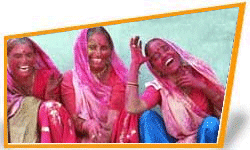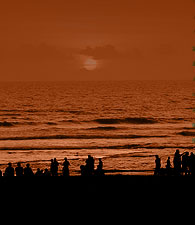Introduction:

Holi celebrates the arrival of spring -the season
of hope and new beginnings and marks the rekindling of the spirit
of life. Gulmohurs, corals, silk-cottons and mango trees start
flowering, gardens and parks present a glorious spectacle of a
riot of colours - crimson, red, pink, orange, golden yellow, lemon
and a variety of glittering greens. It is a celebration of joy
and hope.
Celebrated on:
The festival of Holi begins on Duwadashi - on
the twelfth day of the waxing moon of the month of Phalgun ( March).
Legends of the Festival:
>> Prahlad and Hiranyakasipu
There is one popular legend that is reputed
to bring about the birth of ‘Holi’. It seems that
long ago there was an evil king named King Hiranyakasipu. His
son, prince Prahlad however was very holy and often prayed to
God and this infuriated his father. One day, the wicked king ordered
his sister, the demon Holika, to kill his son. The demon Holika,
who was immune to fire, captured prince Prahlad and entered a
fire furnace. She had done this to kill the prince, however it
was her who was burnt to ashes. Prince Prahlad was safe and was
not burnt at all. The legend goes that before the demon aunt died,
she begged for prince Prahlad’s forgiveness and the prince
forgave her and announced that her name would be remembered once
a year. Thus the festival ‘Holi’ was created.
>> Krishna and Radha
There is also another story behind the festival
of ‘Holi’. Lord Krishna, while growing up in Vraj,
popularised the festival with his ingenious pranks. Gopies of
Vraj responded with equal enthusiasm and the festivities have
continued ever since. Lord Krishna after growing up celebrated
the festival with his lover Radha and it is based on the everlasting
love between Krishna and Radha. It seemed that in the Hindu mythology
Lord Krishna was known to court Radha and the light-hearted mischievous
courtship of his was linked to Holi. Thus Holi is known to be
the celebration of love between the two of them.
>> Lord Shiv and Kamdex, love
guru
In South India specially in Tamilnadu and Kerala
the legend that is popular is of Kamdev-the Love-god, his bow
is of sugarcane having the string of a line of humming bees and
his arrow-shafts are topped with passion that pierce the heart.
In spring he moves through woodlands and hunts birds, beasts and
men. Once in his foolish pride, he aimed his arrow at the mighty
Lord Shiv who was in deep meditation. Lord Shiv opened his third
eye and burnt him to ashes. Grief-stricken Rati, Kamdev's wife
beseeched Lord Shiv to take pity on her and restore her husband
to life. Shiv relented and granted her the boon that she could
see her husband but he would remain "anang" that meant
without the physical human form. Hence, the songs sung during
Holi tell the pathetic tale of Rati and her lamentations. In Tamilnadu
Holi is known by three different names - Kamavilas, Kaman Pandigai
and Kama-dahanam.
Celebrations of the festival:
To start off the festival, preparations are
usually made on the eve of Holi: huge bonfires are burnt as a
symbol of its representation. These fires are created to ward
off evil spirits around the place. 'Holi' is grandly celebrated
in villages around Mathura, the place where Krishna is said to
be born. It is an occasion when people smear each other with bright
colored powders, which are known as Gulal, and colored water.
On this happy occasion, dances and folk songs
are also important features in the festival.
In North India and Uttar Pradesh, this victory
is celebrated, effigies of Holika are burnt in the huge bonfires
that are lit. This tradition is also followed in Gujarat and Orissa.
To render greatfulness to Agni, god of Fire, gram and stalks from
the harvest are also offered to Agni with all humility.
In Bengal this festival is known by the name
of Dol Jatraor Dol Purnima. On this day the idol of Mahaprabhu
Chaitanya, placed in a pictursuqely decorated palanquin is taken
round the main streets of the city. The head of the Bengali family
observes fast and prays to Lord Krishna and Agnidev. After all
the traditional rituals are over, he smears Krishna's idol with
gulal and offers "bhog" to both Krishna and Agnidev.
Mathura and Vrindawan where Krishna cult flourished
and is followed even to-day, this Holi festival is celebrated
with songs, music, plays and dances and of course coloured waters
are thrown on each other. In Nandagaon where the young Krishna
played all his youthful pranks. Holi is observed for many days
and also in Barsana which was the birthplace of Radha Krishna's
beloved. The men-folk of Nandagaon and the women-folk of Barsana
come together and play the game of "Huranga" in which
men abuse women and in retaliation women beat them with sticks
that the men try to avoid with their shields.
This festival of Holi still retains to charm
in Gurudev Rabindranath Tagore's Shanti Niketan. On the Dol Purnima
day in the early morning the students dress up in saffron-coloured
clothes and wear garlands of fragrant flowers. They sing and dance
to the accompaniment of musical instruments before their teachers
and the invited guests, sitting in a colourfully decorated dais.
In the end dry gulal powder and the auspicious black abhir is
smeared on the foreheads of everyone. Use of liquid colours is
fully forbidden.
The Sikh community also celebrates Holi with
feasting and merriment and call it Hola Mohalla.
In Maharashtra Holi is commonly known by the
name of "Shimga" and is also called RANGAPANCHAMI. The
fisherfolk celebrate it on a large-scale with hilarious singing,
dancing and merry-making. To-day this festival retains its significance
mostly in middle-class and the poorer sections of the state.
During the Maratha regime this festival was
celebrated with great pomp and grandeur. It was on a Holi festival
day that five year Jijabhai, daughter of Lakhooji Jadhav innocently
splashed coloured water and threw gulal on young shahaji, son
of Malajirao Bhowale. Taking it as an auspicious event, the two
children's engagement was announced that very day. Soon they were
married. Shivaji, the son born to this couple fought valiantly
and shook the very foundation of the powerful Mogul empire. Thus
Shivaji established the Maratha empire and changed the course
of history.
|







